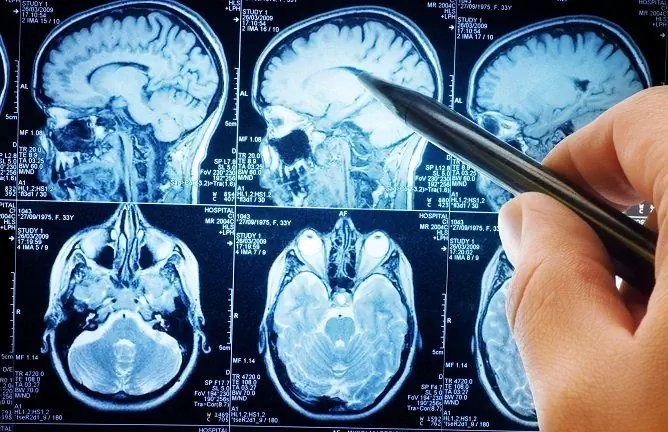- Author Rachel Wainwright [email protected].
- Public 2023-12-15 07:39.
- Last modified 2025-11-02 20:14.
Spermatic cord cyst
The content of the article:
- General information
- Causes and forms of the disease
- Symptoms
- Diagnostics
- Treatment of the cyst of the spermatic cord
- Complications and consequences
- Prevention
- Video
The spermatic cord cyst (funicular) is the accumulation of serous fluid in the space between the leaves of the spermatic cord's own membrane. There are no exact statistics on the prevalence of this pathology, since it is often asymptomatic and is detected by chance when a patient is examined for any other reason or during a routine examination.

The cyst of the spermatic cord, or funicular, in most cases does not require treatment
General information
The spermatic cord is a paired anatomical formation located in the inguinal canal. It acts as a sperm duct and provides mechanical suspension of the testicles. In an adult male, it reaches a length of 20 cm.
The cyst of the spermatic cord is a volume of fluid encapsulated in the connective tissue membrane. The funicular is characterized by the presence of thin walls. The internal cavity of the neoplasm is lined with squamous stratified epithelium. The transudate has a relative density of 1.020-1.023. It contains protein (no more than 2%) and an admixture of male germ cells (formed spermatozoa, immature spermatocytes).
The growth of the cyst is observed during puberty or against the background of venous stasis in the pelvic organs.
Causes and forms of the disease
Due to the onset of funicular, they are divided into congenital and acquired. The differences between them are presented in the table:
| Funicular shape | Development mechanism |
| Congenital | Their development is due to an anomaly in the development of tissues of the genitourinary system, namely, incomplete overgrowth of the mucous membrane of the hole, through which the testicle and the spermatic cord descend into the scrotum. As a result, a cavity is formed, which is gradually filled with a transparent liquid that does not contain germ cells. Sometimes a congenital funicular is combined with other malformations of the organs of the urogenital tract |
| Acquired | The causes of their appearance are trauma or infectious and inflammatory diseases (deferentitis, epididymitis, orchitis, funiculitis) of the genitourinary system. Swelling or damage to the spermatic duct leads to accumulation of seminal fluid and formation of a bulge (diverticulum) |
Congenital funicular is divided into two types:
- Communicating. The proximal part of the vaginal layer of the peritoneum remains open, as a result of which the cystic cavity communicates with the abdominal cavity.
- Isolated (not communicating). In this case, after the formation of a cyst, the peritoneal leaf is completely infected.
Depending on the number of cavities formed by internal partitions, the funicular can be multi-chambered or single-chambered.
The cyst of the spermatic cord in children is more often a congenital pathology, and found in adults is acquired.
Symptoms
In most cases, the funiculocele proceeds without any clinical symptoms and is discovered by chance during palpation of the scrotum by a urologist (andrologist) or by the patient himself in the form of a small rounded formation in the scrotum.
If the walls of the cyst are soldered with the branches of the spermatic nerve, then the patient experiences constant aching and pulling pains, which intensify at the time of physical activity.
Diagnostics
Diagnosis of funicular is usually straightforward and is based on scrotal palpation and ultrasound. Signs of a cyst on palpation are:
- the presence of a volumetric formation of an ovoid or round shape, not associated with the epididymis and testicle;
- a feeling of fluctuation on palpation;
- expansion of the veins of the spermatic cord (not always).
In ultrasound examination of the scrotum, a neoplasm is defined as a volumetric fluid formation of an oval or spherical shape.
Differential diagnosis of funicular is carried out with the following diseases:
- inguinal hernia;
- spermatogenic granuloma;
- spermatic cord tumors;
- spermatocele;
- hydrocele;
- funiculitis.
Treatment of the cyst of the spermatic cord
The indications for surgical removal of a funicocele are:
- aesthetic discomfort;
- inconvenience when walking and other types of physical activity;
- frequent and palpable pain.
The operation to remove the funiculocele consists in dissecting the formation, removing the liquid contents and peeling the walls. It is usually performed on an outpatient basis under local anesthesia and lasts no more than half an hour.
Recommendations for the patient in the postoperative period:
- Timely take medications prescribed by the urologist.
- Wear a brace or a swimsuit that keeps the scrotum in an elevated position.
- Treat the postoperative wound daily with an antiseptic solution (hydrogen peroxide, brilliant green, ethyl alcohol).
- Refrain from sexual intercourse.
- Refuse to visit the pool, sauna, gym.
- Avoid both overheating and hypothermia.
In boys, treatment for cystic formation begins with puncture and removal of fluid. In many cases, after this procedure, obliteration (infection) of the vaginal process of the peritoneum occurs. In case of ineffectiveness of puncture treatment of funicular, a radical operation is indicated.
Complications and consequences
The prognosis for funicular is favorable. However, with injuries of the external genital organs, rupture of the cystic formation with the outpouring of fluid can occur. This, in turn, becomes the cause of suppuration of the tissues of the scrotum, the formation of an abscess, and necrosis. It is extremely rare that funicular is complicated by:
- deformation of the scrotum;
- reproductive disorders (with bilateral cysts of significant size).
Prevention
Prevention of the formation of funicular is the prevention of trauma to the external genital organs and local inflammatory diseases.
If any neoplasms are found in the scrotum, the patient should definitely visit a urologist and undergo the examination necessary in each specific case.
Video
We offer for viewing a video on the topic of the article.

Elena Minkina Doctor anesthesiologist-resuscitator About the author
Education: graduated from the Tashkent State Medical Institute, specializing in general medicine in 1991. Repeatedly passed refresher courses.
Work experience: anesthesiologist-resuscitator of the city maternity complex, resuscitator of the hemodialysis department.
Found a mistake in the text? Select it and press Ctrl + Enter.






